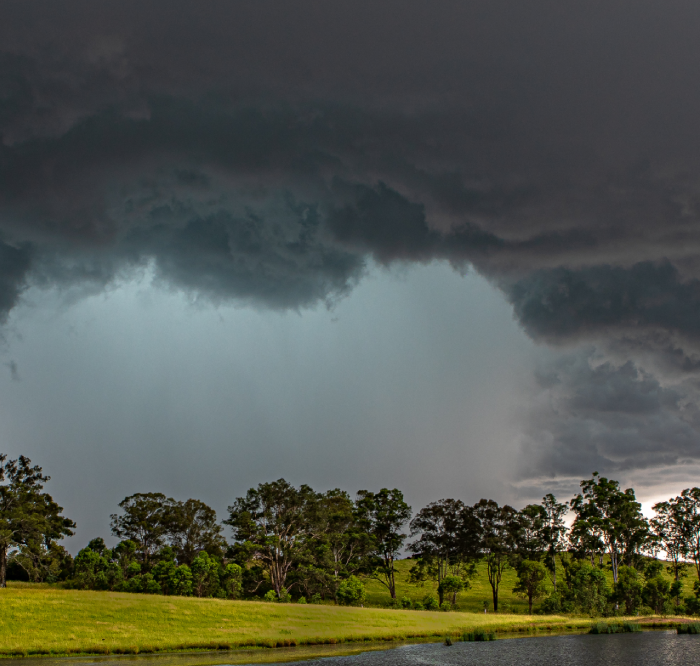Ginger Cove HOA Ultrasonic Algae Removal Success

Residents impressed as Ginger Cove lake’s quality and clarity look better than it has in 40 years
Located in Valley, Nebraska, Ginger Cove is a premier spring-fed, sand-bottom lake home community founded in 1966. Spanning nearly 100 acres of lake and 40 acres of greenspace, Ginger Cove also tout’s Nebraska’s longest genuine covered bridge. The community boasts 160 residential lots that are home to both full-time and part-time residents. The lake at Ginger Cove has an average depth of 17 feet, with some areas reaching a depth of 40 feet. It is fully equipped for recreational activities, such as fishing, boating, and water sports. Over the years, generations of residents have cherished the picturesque beauty of this close-knit lake community.
The Challenge
For the past four decades, water quality management has been a continuous challenge for the residents of Ginger Cove. Numerous methods have been implemented to control the growth of nuisance filamentous algae and harmful blue-green algae. For example, an aeration system was installed in the lake during the early 2000s to alleviate seasonal algae blooms. Although the system helped enhance oxygen levels and aquatic life, it failed to significantly improve water quality or decrease the severity of algae blooms.
In the following years, the HOA board consulted with water quality specialists to find a resolution to the escalating algae blooms and declining water clarity. One recommendation was to apply an Alum treatment to neutralize the algae nutrient, phosphorous. However, this was costly and ineffective as it did nothing to reduce nitrogen – the other nutrient critical to plant and algae growth. Then in 2016, a new HOA board member named Carly Dana initiated a revamped water quality program aimed at both reducing chemical use to ensure a more environmentally friendly approach to water quality management.
According to Dana, “There was a realization that years of chemical-based treatments and other techniques had not proven to be effective. Therefore, we looked toward the latest science and technology to discover new and more effective solutions that were environmentally friendly so that fish and other wildlife were not harmed by their use.”
To address the high levels of phosphorus and nitrogen in Ginger Cove’s lake, a bacterial enzyme application program was implemented during the summer months. The program aimed to reduce muck accumulation, and improve water clarity during the first season. Since then, the bacterial enzyme application program has continued for the past six years, resulting in a notable reduction in phosphorus levels, undetectable nitrogen levels, and fewer filamentous algae blooms.
However, despite its success, the program had not been able to prevent harmful blue-green algae blooms. The lake still faced this issue, where visually unappealing blooms disrupted the residents’ and their pets’ enjoyment of the lake. In some instances, the water tested positive for low levels of microcystin, a potent cyanotoxin that is harmful to aquatic animals and can produce adverse health effects in humans, from a mild skin rash to serious illness or in rare circumstances, death. The sole option considered at the time to address Harmful Algae Blooms (HABs) were chelated copper chemical treatments, resulting in high costs and damage to the bacterial enzyme program and the lake’s ecosystem.
Blue-green algae is actually a form of cyanobacteria that thrives during the spring and summer months. Homeowner Associations (HOAs) such as Ginger Cove have been under tremendous pressure to implement measures that can effectively mitigate the proliferation of this menace to lakes and ponds. However, the trial and error approach to finding a solution to the cyanobacterial blooms had resulted in the use of chemicals that were proven harmful to both wildlife and algal variants in the lake. Recent research has revealed that many of these chemicals have long-term ecological impacts on the ecosystem and must be avoided.
The consequences of not treating the cyanobacterial blooms are severe as they pose a significant threat to public health, can cause damage to the infrastructure, reduce property values, and result in a loss of revenue from recreational activities. In addition, the economic cost of treating algae blooms can be significant. A 2019 report from the Environmental Protection Agency (EPA) estimated the annual cost of managing cyanobacteria blooms in the US to be $4.6 billion. Therefore, finding effective, environmentally friendly solutions to control cyanobacterial blooms is critical.


